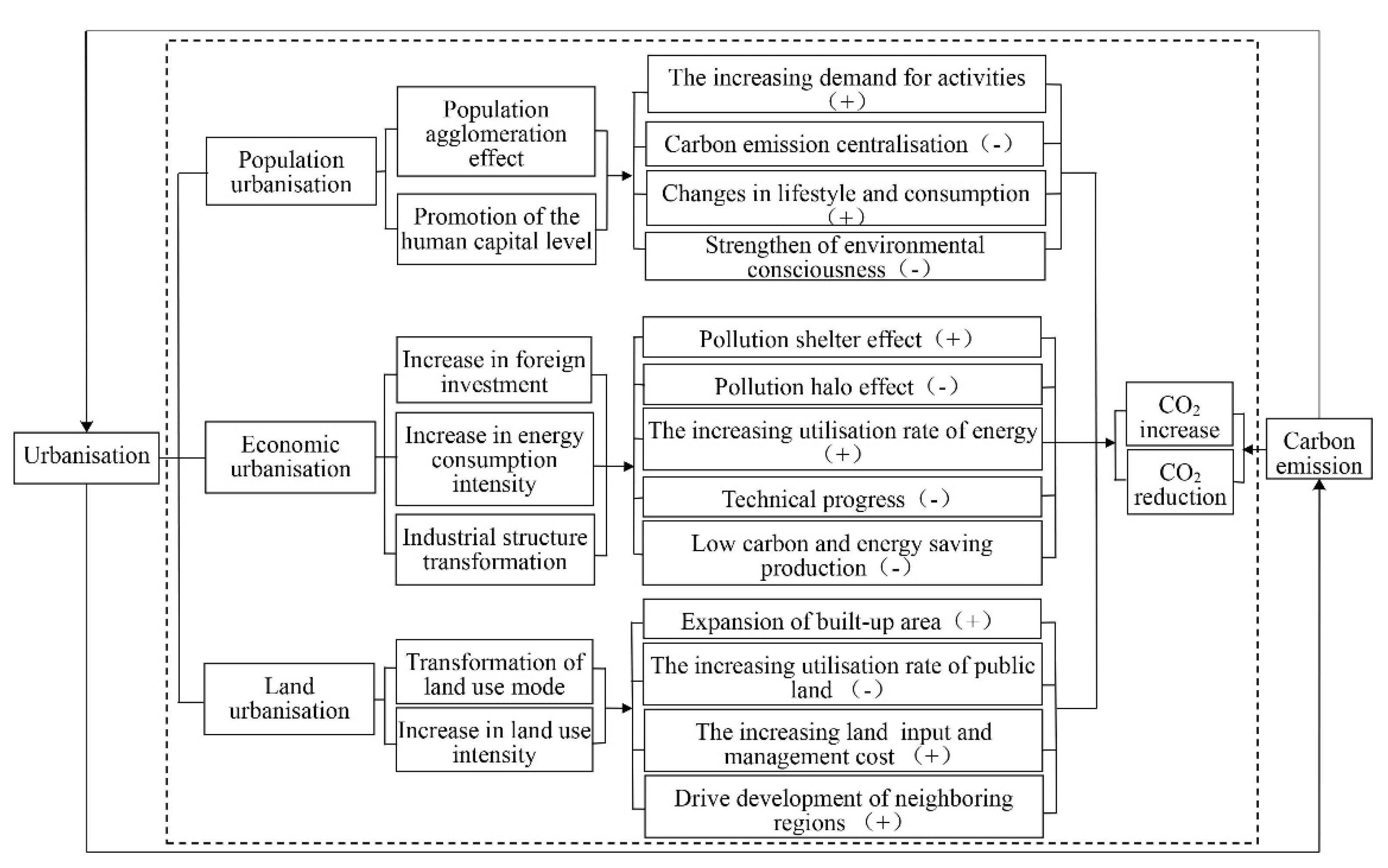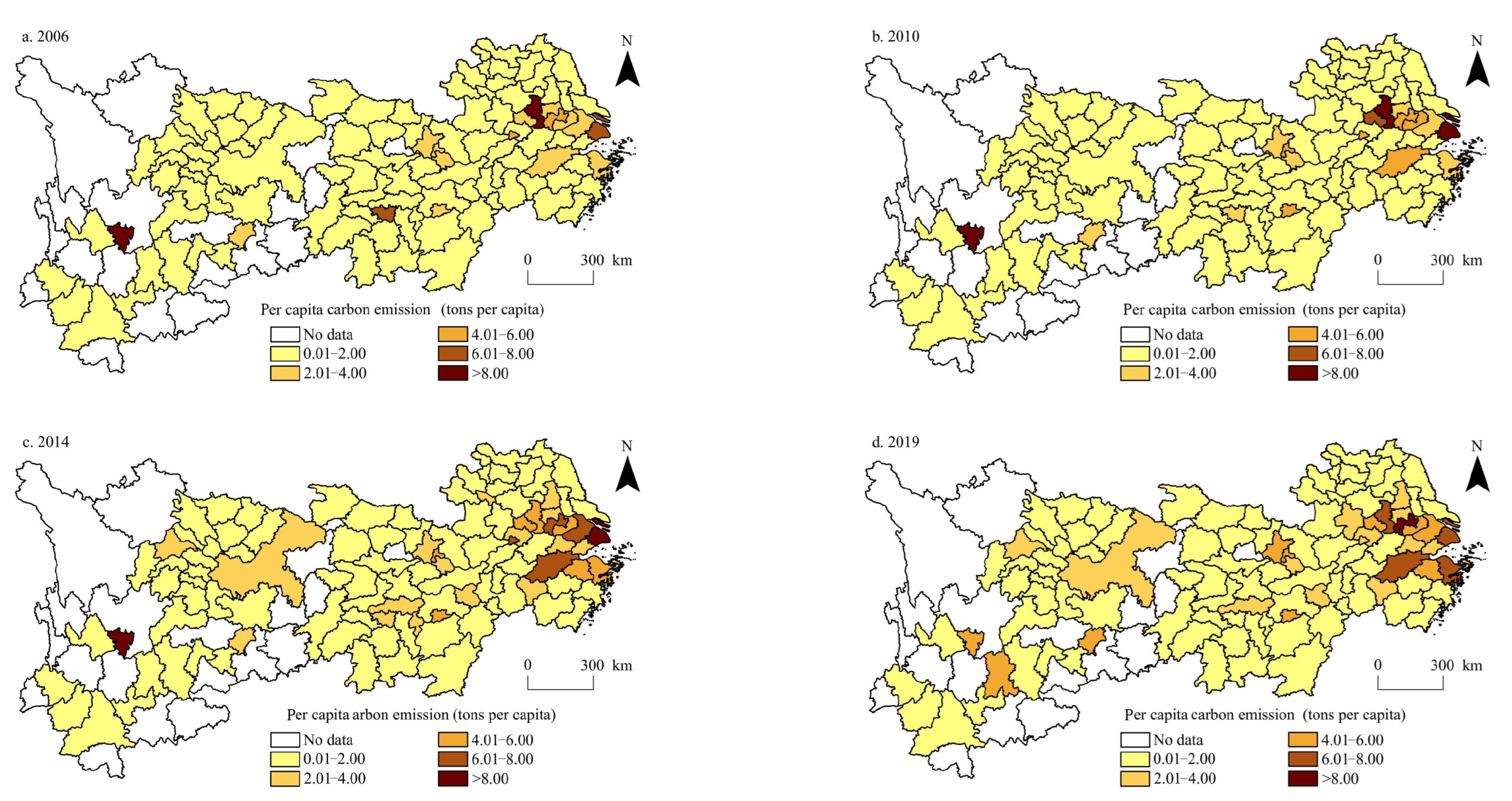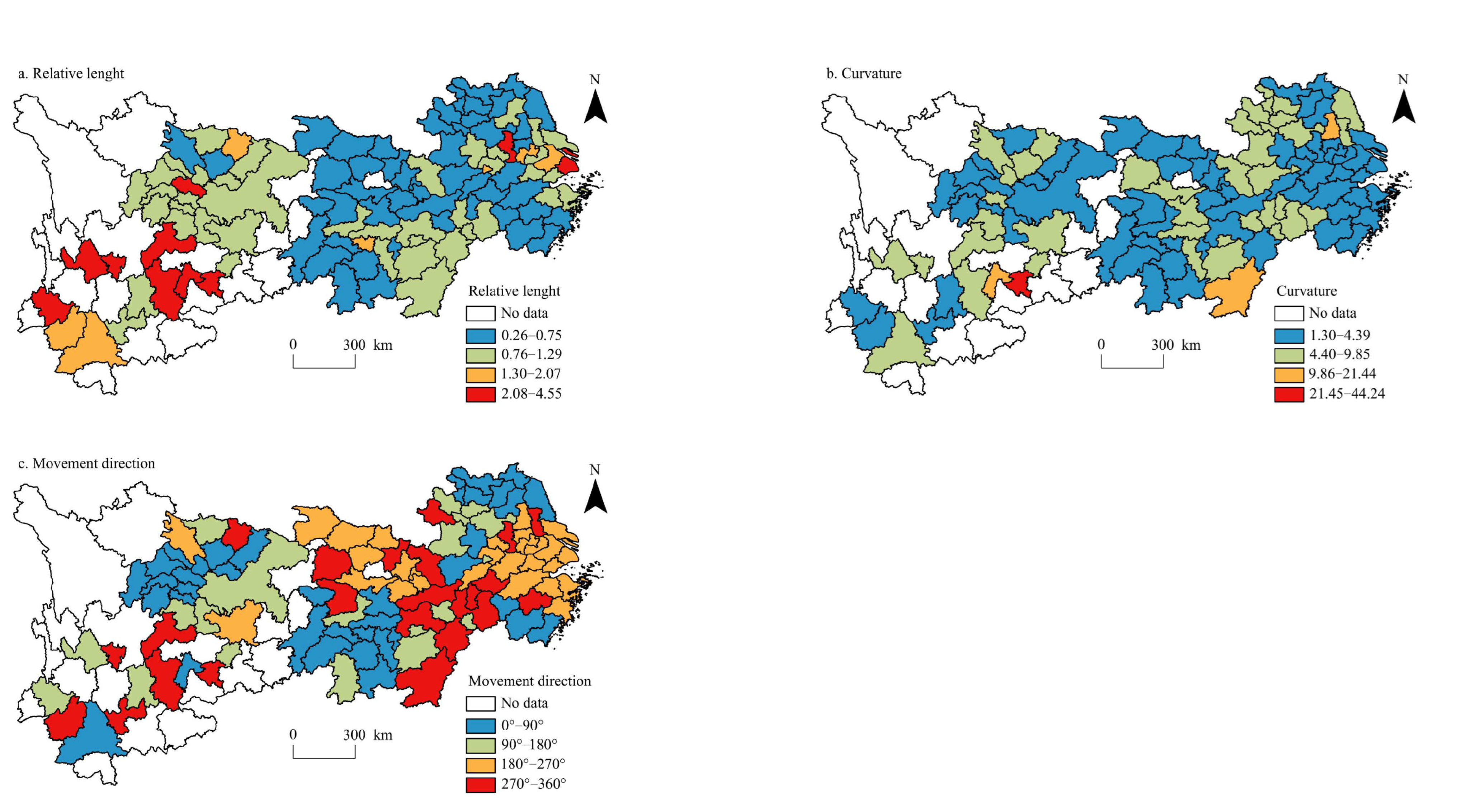Spatio-Temporal Coupling Evolution of Urbanisation and Carbon Emission in the Yangtze River Economic Belt
Abstract
:1. Introduction
2. Spatial Coupling Mechanism of Urbanisation and Carbon Emission
3. Data Sources and Methods
3.1. Study Area and Data Sources
3.1.1. Study Area
3.1.2. Data Sources
3.2. Research Methods
3.2.1. Measurement of Urbanisation Level
3.2.2. Coupling Coordination Degree Model
3.2.3. Exploratory Spatial–Temporal Data Analysis
4. Results
4.1. Distribution Characteristics of Urbanisation Level and Carbon Emission
4.2. Spatio-Temporal Coupling Evolution of Urbanisation and Carbon Emissions
4.2.1. Coupling Coordination Degree of Urbanisation and Per Capita Carbon Emissions
4.2.2. LISA Time Path Analysis of Coupling Coordination Degree of Urbanisation Level and Per Capita Carbon Emissions
4.2.3. LISA Spatio-Temporal Transition Analysis of Coupling Coordination Degree of Urbanisation Level and Per Capita Carbon Emissions
5. Discussion and Conclusions
5.1. Discussion
5.2. Conclusions
Author Contributions
Funding
Institutional Review Board Statement
Informed Consent Statement
Data Availability Statement
Acknowledgments
Conflicts of Interest
References
- Shan, Y.; Guan, D.; Liu, J.; Mi, Z.; Liu, Z.; Liu, J.; Schroeder, H.; Cai, B.; Chen, Y.; Shao, S.; et al. Methodology and applications of city level CO2 emission accounts in China. J. Clean. Prod. 2017, 161, 1215–1225. [Google Scholar] [CrossRef] [Green Version]
- Ishii, S.; Tabushi, S.; Aramaki, T.; Hanaki, K. Impact of future urban form on the potential to reduce greenhouse gas emissions from residential, commercial and public buildings in Utsunomiya, Japan. Energy Policy 2010, 38, 4888–4896. [Google Scholar] [CrossRef]
- Xia, C.Y.; Li, Y.; Xu, T.B.; Ye, Y.M.; Shi, Z.; Peng, Y.; Liu, J.M. Quantifying the spatial patterns of urban carbon metabolism: A case study of Hangzhou, China. Ecol. Indic. 2018, 95, 474–484. [Google Scholar] [CrossRef]
- Zhu, E.; Qi, Q.Y.; Sha, M. Identify the effects of urbanization on carbon emissions (EUCE): A global scientometric visualization analysis from 1992 to 2018. Environ. Sci. Pollut. Res. Int. 2021, 28, 31358–31369. [Google Scholar] [CrossRef] [PubMed]
- Song, W.X.; Yin, S.G.; Zhang, Y.H.; Qi, L.S.Y.; Yi, X. Spatial-temporal evolution characteristics and drivers of carbon emission intensity of resource-based cities in China. Front. Environ. Sci. 2022, 10, 972563. [Google Scholar] [CrossRef]
- Jin, B.L.; Han, Y. Influencing factors and decoupling analysis of carbon emissions in China’s manufacturing industry. Environ. Sci. Pollut. Res. Int. 2021, 28, 64719–64738. [Google Scholar] [CrossRef]
- Wang, W.X.; Zhao, D.Q.; Kuang, Y. Decomposition analysis on influence factors of direct household energy-related carbon emission in Guangdong Province-Based on extended Kaya identity. Environ. Prog. Sustain. Energy 2016, 35, 298–307. [Google Scholar] [CrossRef] [Green Version]
- Liang, X.Y.; Min, F.; Xiao, Y.T.; Yao, J. Temporal-spatial characteristics of energy-based carbon dioxide emissions and driving factors during 2004–2019, China. Energy 2022, 261, 124965. [Google Scholar] [CrossRef]
- Zhao, Q.; Zhou, Y.L.; Fang, Q.S.; Yi, J.M. Spatial-temporal evolution of carbon emissions and its influencing factors in China Central Region. Acta Sci. Circum. 2023, 43, 1–11. (In Chinese) [Google Scholar]
- Guo, X.Y.; He, J.L.; Lan, M.; Yu, H.; Yan, W. Modeling carbon emission estimation for hinterland-based container intermodal network. J. Clean. Prod. 2022, 378, 134593. [Google Scholar] [CrossRef]
- Ryu, B.Y.; Jung, H.J.; Bae, S.H. Development of a corrected average speed model for calculating carbon dioxide emissions per link unit on urban roads. Transp. Res. Part D Transp. Environ. 2015, 34, 245–254. [Google Scholar] [CrossRef]
- Chen, W.Y.; Zhang, L.G.; Shi, L.J.; Shao, Y.Q.; Zhou, K.H. Carbon emissions trading system and investment efficiency: Evidence from China. J. Clean. Prod. 2022, 358, 131782. [Google Scholar] [CrossRef]
- Wu, L.P.; Gong, Z.W. Can national carbon emission trading policy effectively recover GDP losses? A new linear programming-based three-step estimation approach. J. Clean. Prod. 2021, 287, 125052. [Google Scholar] [CrossRef]
- Zhang, J.; Yuan, J.T.; Zi, F.J. Does the improvement of transportation efficiency reduce the carbon emission of transportation industry? An empirical research based on provincial panel data. Ecol. Econ. 2021, 37, 18–24. (In Chinese) [Google Scholar]
- Yang, Z.K.; Zhang, M.M.; Liu, L.Y.; Zhou, D.Q. Can renewable energy investment reduce carbon dioxide emissions? Evidence from scale and structure. Energy Econ. 2022, 112, 106181. [Google Scholar] [CrossRef]
- Cheng, Z.H.; Hu, X.W. The effects of urbanization and urban sprawl on CO2 emissions in China. Environ. Dev. Sustain. 2022, 25, 1792–1808. [Google Scholar] [CrossRef]
- Lin, S.F.; Wang, S.Y.; Marinova, D.; Zhao, D.T.; Hong, J. Impacts of urbanization and real economic development on CO2 emissions in non-high income countries: Empirical research based on the extended STIRPAT model. J. Clean. Prod. 2017, 166, 952–966. [Google Scholar] [CrossRef]
- Huo, T.F.; Li, X.H.; Cai, W.G.; Zuo, J.; Jia, F.Y.; Wei, H.F. Exploring the impact of urbanization on urban building carbon emissions in China: Evidence from a provincial panel data model. Sustain. Cities Soc. 2020, 56, 102068. [Google Scholar] [CrossRef]
- Yuan, L.; Li, Y.; Li, Z.H.; Wang, Z.; Zheng, J. Urbanization process and its effects on carbon emissions—A case study of Beijing city. Adv. Mater. Res. 2013, 807–809, 1059–1066. [Google Scholar] [CrossRef]
- Chen, F.Z.; Liu, A.W.; Lu, X.L.; Zhe, R.; Tong, J.C.; Akram, R. Evaluation of the effects of urbanization on carbon emissions: The transformative role of government effectiveness. Front. Energy Res. 2022, 10, 115. [Google Scholar] [CrossRef]
- Wang, Q.; Wang, L.L. The nonlinear effects of population aging, industrial structure, and urbanization on carbon emissions: A panel threshold regression analysis of 137 countries. J. Clean. Prod. 2021, 287, 125381. [Google Scholar] [CrossRef]
- Pang, Q.H.; Zhou, W.M.; Zhao, T.X.; Zhang, L.N. Impact of urbanization and industrial structure on carbon emissions: Evidence from Huaihe River eco-economic zone. Land 2021, 10, 1130. [Google Scholar] [CrossRef]
- Balsalobre-Lorente, D.; Driha, O.M.; Halkos, G.; Mishra, S. Influence of growth and urbanization on CO2 emissions: The moderating effect of foreign direct investment on energy use in BRICS. Sustain. Dev. 2022, 30, 227–240. [Google Scholar] [CrossRef]
- Zhou, Y.; Chen, M.X.; Tang, Z.P.; Mei, Z. Urbanization, land use change, and carbon emissions: Quantitative assessments for city-level carbon emissions in Beijing-Tianjin-Hebei region. Sustain. Cities Soc. 2021, 66, 102701. [Google Scholar] [CrossRef]
- Sadorsky, P. The effect of urbanization on CO2 emissions in emerging economies. Energy Econ. 2014, 41, 147–153. [Google Scholar] [CrossRef]
- Wang, Y.; Li, L.; Kubota, J.; Han, R.; Zhu, X.D.; Lu, G.F. Does urbanization lead to more carbon emission? Evidence from a panel of BRICS countries. Appl. Energy 2016, 168, 375–380. [Google Scholar] [CrossRef]
- Al-mulali, U.; Binti Che Sab, C.N.; Fereidouni, H.G. Exploring the bi-directional long run relationship between urbanization, energy consumption, and carbon dioxide emission. Energy 2012, 46, 156–167. [Google Scholar] [CrossRef]
- Adamsa, S.; Nsiahb, C. Reducing carbon dioxide emissions; Does renewable energy matter? Sci. Total Environ. 2019, 693, 133288. [Google Scholar] [CrossRef]
- Susan, S.S. Determinants of carbon dioxide emissions: Empirical evidence from 69 countries. Appl. Energy 2010, 88, 376–382. [Google Scholar]
- Rong, T.Q.; Zhang, P.Y.; Zhu, H.R.; Jiang, L.; Li, Y.Y.; Liu, Z.Y. Spatial correlation evolution and prediction scenario of land use carbon emissions in China. Ecol. Inform. 2022, 71, 101802. [Google Scholar] [CrossRef]
- Bekhet, H.A.; Othman, N.S. Impact of urbanization growth on Malaysia CO2 emissions: Evidence from the dynamic relationship. J. Clean. Prod. 2017, 154, 374–388. [Google Scholar] [CrossRef] [Green Version]
- He, Z.X.; Xu, S.C.; Shen, W.X.; Long, R.Y.; Chen, H. Impact of urbanization on energy related CO2 emission at different development levels: Regional difference in China based on panel estimation. J. Clean. Prod. 2017, 140, 1719–1730. [Google Scholar] [CrossRef]
- Chen, S.T.; Jin, H.; Lu, Y.L. Impact of urbanization on CO2 emissions and energy consumption structure: A panel data analysis for Chinese prefecture-level cities. Struct. Change Econ. Dyn. 2019, 49, 107–119. [Google Scholar] [CrossRef]
- Guo, X.M.; Fang, C.L. How does urbanization affect energy carbon emissions under the background of carbon neutrality? J. Environ. Manag. 2023, 327, 116878. [Google Scholar] [CrossRef]
- Cao, Q.R.; Kang, W.; Xu, S.C.; Sajid, M.J.; Cao, M. Estimation and decomposition analysis of carbon emissions from the entire production cycle for Chinese household consumption. J. Environ. Manag. 2019, 247, 525–537. [Google Scholar] [CrossRef]
- Wu, C.D.; Chen, K.L. The research progress on the relation between foreign urbanization and carbon emission. Urban Probl. 2014, 22–27. [Google Scholar] [CrossRef]
- Muhammad, S.; Long, X.L.; Salman, M.; Dauda, L. Effect of urbanization and international trade on CO2 emissions across 65 belt and road initiative countries. Energy 2020, 196, 117102. [Google Scholar] [CrossRef]
- Meng, G.F.; Guo, Z.; Li, J.L. The dynamic linkage among urbanisation, industrialisation and carbon emissions in China: Insights from spatiotemporal effect. Sci. Total Environ. 2021, 760, 144042. [Google Scholar] [CrossRef]
- Liu, H.C.; Wong, W.K.; Cong, P.T.; Nassani, A.A.; Haffar, M.; Abu-Rumman, A. Linkage among urbanization, energy consumption, economic growth and carbon emissions. Panel Data Anal. China Using ARDL Model. Fuel. 2022, 332, 126122. [Google Scholar] [CrossRef]
- Li, S.N.; Shao, Y.Z.; Hong, M.J.; Zhu, C.M.; Dong, B.Y.; Li, Y.J.; Lin, Y.; Wang, K.; Gan, M.Y.; Zhu, J.X.; et al. Impact mechanisms of urbanisation processes on supply-demand matches of cultivated land multifunction in rapid urbanisation areas. Habitat Int. 2023, 131, 102726. [Google Scholar] [CrossRef]
- Wang, X.; Qin, M. An empirical study of different urbanisation qualities affecting carbon emissions. J. Lanzhou Univ. (Soc. Sci.) 2015, 43, 60–66. (In Chinese) [Google Scholar]
- Zhou, C.S.; Wang, S.J.; Wang, J.Y. Examining the influences of urbanisation on carbon dioxide emissions in the Yangtze River Delta, China: Kuznets curve relationship. Sci. Total Environ. 2019, 675, 472–482. [Google Scholar] [CrossRef] [PubMed]
- Zhang, W.S.; Xu, Y.; Jiang, L.; Streets, D.G.; Wang, C. Direct and spillover effects of new-type on CO2 emissions from central heating sector and EKC analyses: Evidence from 144 cities in China. Resour. Conserv. Recy. 2023, 192, 106913. [Google Scholar] [CrossRef]
- Wei, G.E.; Bi, M.; Liu, X.; Zheng, Z.K.; He, B.J. Investigating the impact of multi-dimensional and FDI on carbon emissions in the belt and road initiative region: Direct and spillover effects. J. Clean. Prod. 2023, 384, 135608. [Google Scholar] [CrossRef]
- Lv, T.G.; Hu, H.; Zhang, X.M.; Wang, L.; Fu, S.F. Impact of multidimensional on carbon emissions in an ecological civilization experimental area of China. Phys. Chem. Earth 2022, 126, 103120. [Google Scholar] [CrossRef]
- Chen, J.D.; Gao, M.; Cheng, S.L.; Hou, W.X.; Song, M.; Liu, X.; Liu, Y.; Shan, Y. County-level CO2 emissions and sequestration in China during 1997–2017. Sci. Data 2020, 7, 391. [Google Scholar] [CrossRef]
- Ye, Y.; Qiu, H.F. Environmental and social benefits, and their coupling coordination in urban wetland parks. Urban For. Urban Green. 2021, 60, 127043. [Google Scholar] [CrossRef]
- Li, W.Y.; Ji, Z.S.; Dong, F.G. Spatio-temporal analysis of decoupling and spatial clustering decomposition of CO2 emissions in 335 Chinese cities. Sustain. Cities Soc. 2022, 86, 104156. [Google Scholar] [CrossRef]
- Yin, X.L.; Xu, Z.R. An empirical analysis of the coupling and coordinative development of China’s green finance and economic growth. Resour. Policy 2022, 75, 102476. [Google Scholar] [CrossRef]
- Geng, Y.Q.; Wang, R.; Wei, Z.J.; Zhai, Q.H. Temporal-spatial measurement and prediction between air environment and inbound tourism: Case of China. J. Clean. Prod. 2021, 287, 125486. [Google Scholar] [CrossRef]
- Zeng, P.; Wei, X.; Duan, Z.C. Coupling and coordination analysis in urban agglomerations of China: Urbanization and ecological security perspectives. J. Clean. Prod. 2022, 365, 132730. [Google Scholar] [CrossRef]
- Cheng, T.; Zhao, Y.H.; Zhao, C.J. Exploring the spatio-temporal evolution of economic resilience in Chinese cities during the COVID-19 crisis. Sustain. Cities Soc. 2022, 84, 103997. [Google Scholar] [CrossRef]
- Murray, A.T.; Liu, Y.; Rey, S.J.; Anselin, L. Exploring movement object patterns. Ann. Reg. Sci. 2012, 49, 471–484. [Google Scholar] [CrossRef]
- Rey, S.J.; Murray, A.T.; Anselin, L. Visualizing regional income distribution dynamics. Lett. Spat. Resour. Sci. 2011, 4, 81–90. [Google Scholar] [CrossRef]
- Rey, S.J.; Janikas, M.V. STARS: Space-time analysis of regional systems. Geogr. Anal. 2006, 38, 67–86. [Google Scholar] [CrossRef]
- Jung, M.C.; Kang, M.; Kim, S. Does polycentric development produce less transportation carbon emissions? Evidence from urban form identified by night-time lights across US metropolitan areas. Urban Clim. 2022, 44, 101223. [Google Scholar] [CrossRef]
- Zhou, K.L.; Yang, J.N.; Yang, T.; Ding, T. Spatial and temporal evolution characteristics and spillover effects of China’s regional carbon emissions. J. Environ. Manag. 2023, 325, 116423. [Google Scholar] [CrossRef]
- Han, G.X.; Shi, Y.L.; Lu, Y.L.; Liu, C.F.; Cui, H.T.; Zhang, M. Coupling relation between urbanization and ecological risk of PAHs on coastal terrestrial ecosystem around the Bohai and Yellow Sea. Environ. Pollut. 2021, 268, 115680. [Google Scholar] [CrossRef]
- Sun, X.; Zhu, B.K.; Zhang, S.; Zeng, H.; Li, K.; Wang, B.; Dong, Z.F.; Zhou, C.C. New indices system for quantifying the nexus between economic-social development, natural resources consumption, and environmental pollution in China during 1978–2018. Sci. Total Environ. 2022, 804, 150180. [Google Scholar] [CrossRef]
- Du, Y.Y.; Sun, T.S.; Peng, J.; Fang, K.; Liu, Y.X.; Yang, Y.; Wang, Y.L. Direct and spillover effects of urbanization on PM2.5 concentrations in China’s top three urban agglomerations. J. Clean. Prod. 2018, 190, 72–83. [Google Scholar] [CrossRef]
- Jiang, J.K.; Zhu, S.L.; Wang, W.H.; Li, Y.; Li, N. Coupling coordination between new urbanisation and carbon emissions in China. Sci. Total Environ. 2022, 850, 158076. [Google Scholar] [CrossRef] [PubMed]
- Song, Q.J.; Zhou, N.; Liu, T.L.; Siehr, S.A.; Qi, Y. Investigation of a “coupling model” of coordination between low-carbon development and urbanisation in China. Energy Policy 2018, 121, 346–354. [Google Scholar] [CrossRef] [Green Version]






| Type | Spatio-Temporal Leap Form | Symbolic Representation |
|---|---|---|
| Type I | Self-leap—neighbourhood stability | HHt → LHt+1, LHt → HHt+1, LLt → HLt+1, HLt → LLt+1 |
| Type II | Self-stability—neighbourhood leap | HHt → HLt+1, LHt → LLt+1, LLt → LHt+1, HLt → HHt+1 |
| Type III | Self-leap—neighbourhood leap | HHt → LLt+1, LHt → HLt+1, LLt → HHt+1, HLt → LHt+1 |
| Type IV | Self-stability—neighbourhood stability | HHt → HHt+1, LHt → LHt+1, LLt → LLt+1, HLt → HLt+1 |
| Time Period | t/t+1 | HH | LH | LL | HL | Type | Quantity | Proportion | SF | SC |
|---|---|---|---|---|---|---|---|---|---|---|
| From 2006 to 2010 | HH | 0.9015 | 0.0394 | 0.0099 | 0.0493 | Type Ⅰ | 23 | 0.0532 | 0.1042 | 0.8935 |
| LH | 0.1294 | 0.8353 | 0.0353 | 0.0000 | Type Ⅱ | 22 | 0.0509 | |||
| LL | 0.0100 | 0.0100 | 0.9600 | 0.0200 | Type Ⅲ | 4 | 0.0093 | |||
| HL | 0.1818 | 0.0227 | 0.0455 | 0.7500 | Type Ⅳ | 383 | 0.8866 | |||
| From 2010 to 2014 | HH | 0.9307 | 0.0594 | 0.0000 | 0.0099 | Type Ⅰ | 21 | 0.0486 | 0.0880 | 0.9120 |
| LH | 0.0976 | 0.8902 | 0.0122 | 0.0000 | Type Ⅱ | 17 | 0.0394 | |||
| LL | 0.0000 | 0.0377 | 0.9528 | 0.0094 | Type Ⅲ | 0 | 0.0000 | |||
| HL | 0.2381 | 0.0000 | 0.0000 | 0.7619 | Type Ⅳ | 394 | 0.9120 | |||
| From 2014 to 2019 | HH | 0.8718 | 0.0427 | 0.0128 | 0.0726 | Type Ⅰ | 27 | 0.0500 | 0.1185 | 0.8704 |
| LH | 0.0992 | 0.8264 | 0.0496 | 0.0248 | Type Ⅱ | 37 | 0.0685 | |||
| LL | 0.0084 | 0.0756 | 0.8992 | 0.0168 | Type Ⅲ | 10 | 0.0185 | |||
| HL | 0.0758 | 0.0455 | 0.0455 | 0.8333 | Type Ⅳ | 466 | 0.8630 | |||
| From 2006 to 2019 | HH | 0.8998 | 0.0469 | 0.0078 | 0.0454 | Type Ⅰ | 71 | 0.0506 | 0.1047 | 0.8903 |
| LH | 0.1076 | 0.8472 | 0.0347 | 0.0104 | Type Ⅱ | 76 | 0.0541 | |||
| LL | 0.0062 | 0.0431 | 0.9354 | 0.0154 | Type Ⅲ | 14 | 0.0100 | |||
| HL | 0.1513 | 0.0263 | 0.0329 | 0.7895 | Type Ⅳ | 1243 | 0.8853 |
Disclaimer/Publisher’s Note: The statements, opinions and data contained in all publications are solely those of the individual author(s) and contributor(s) and not of MDPI and/or the editor(s). MDPI and/or the editor(s) disclaim responsibility for any injury to people or property resulting from any ideas, methods, instructions or products referred to in the content. |
© 2023 by the authors. Licensee MDPI, Basel, Switzerland. This article is an open access article distributed under the terms and conditions of the Creative Commons Attribution (CC BY) license (https://creativecommons.org/licenses/by/4.0/).
Share and Cite
Fu, H.; Li, B.; Liu, X.; Zheng, J.; Yin, S.; Jiang, H. Spatio-Temporal Coupling Evolution of Urbanisation and Carbon Emission in the Yangtze River Economic Belt. Int. J. Environ. Res. Public Health 2023, 20, 4483. https://doi.org/10.3390/ijerph20054483
Fu H, Li B, Liu X, Zheng J, Yin S, Jiang H. Spatio-Temporal Coupling Evolution of Urbanisation and Carbon Emission in the Yangtze River Economic Belt. International Journal of Environmental Research and Public Health. 2023; 20(5):4483. https://doi.org/10.3390/ijerph20054483
Chicago/Turabian StyleFu, Huijuan, Bo Li, Xiuqing Liu, Jiayi Zheng, Shanggang Yin, and Haining Jiang. 2023. "Spatio-Temporal Coupling Evolution of Urbanisation and Carbon Emission in the Yangtze River Economic Belt" International Journal of Environmental Research and Public Health 20, no. 5: 4483. https://doi.org/10.3390/ijerph20054483




